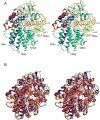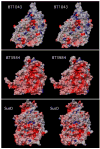Structure of a SusD homologue, BT1043, involved in mucin O-glycan utilization in a prominent human gut symbiont
- PMID: 19191477
- PMCID: PMC2655733
- DOI: 10.1021/bi801942a
Structure of a SusD homologue, BT1043, involved in mucin O-glycan utilization in a prominent human gut symbiont
Abstract
Mammalian distal gut bacteria have an expanded capacity to utilize glycans. In the absence of dietary sources, some species rely on host-derived mucosal glycans. The ability of Bacteroides thetaiotaomicron, a prominent human gut symbiont, to forage host glycans contributes to both its ability to persist within an individual host and its ability to be transmitted naturally to new hosts at birth. The molecular basis of host glycan recognition by this species is still unknown but likely occurs through an expanded suite of outermembrane glycan-binding proteins that are the primary interface between B. thetaiotaomicron and its environment. Presented here is the atomic structure of the B. thetaiotaomicron protein BT1043, an outer membrane lipoprotein involved in host glycan metabolism. Despite a lack of detectable amino acid sequence similarity, BT1043 is a structural homologue of the B. thetaiotaomicron starch-binding protein SusD. Both structures are dominated by tetratrico peptide repeats that may facilitate association with outer membrane beta-barrel transporters required for glycan uptake. The structure of BT1043 complexed with N-acetyllactosamine reveals that recognition is mediated via hydrogen bonding interactions with the reducing end of beta-N-acetylglucosamine, suggesting a role in binding glycans liberated from the mucin polypeptide. This is in contrast to CBM 32 family members that target the terminal nonreducing galactose residue of mucin glycans. The highly articulated glycan-binding pocket of BT1043 suggests that binding of ligands to BT1043 relies more upon interactions with the composite sugar residues than upon overall ligand conformation as previously observed for SusD. The diversity in amino acid sequence level likely reflects early divergence from a common ancestor, while the unique and conserved alpha-helical fold the SusD family suggests a similar function in glycan uptake.
Figures





References
Publication types
MeSH terms
Substances
Associated data
- Actions
- Actions
- Actions
- Actions
Grants and funding
LinkOut - more resources
Full Text Sources
Other Literature Sources
Molecular Biology Databases

